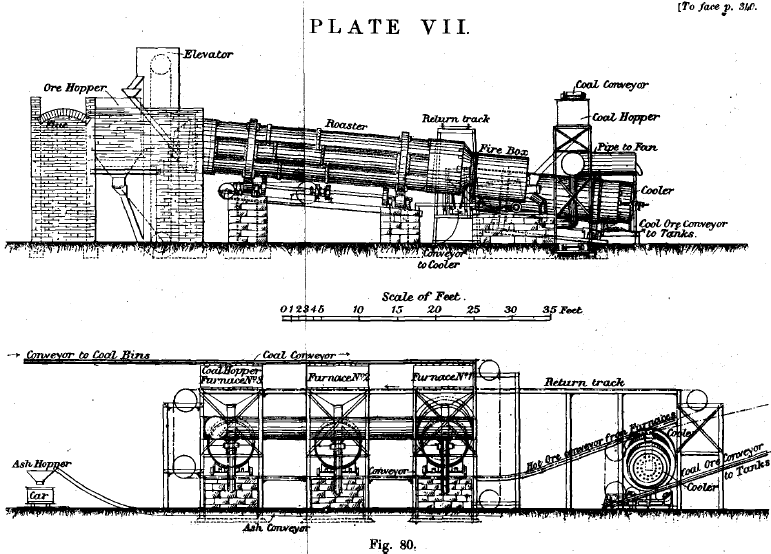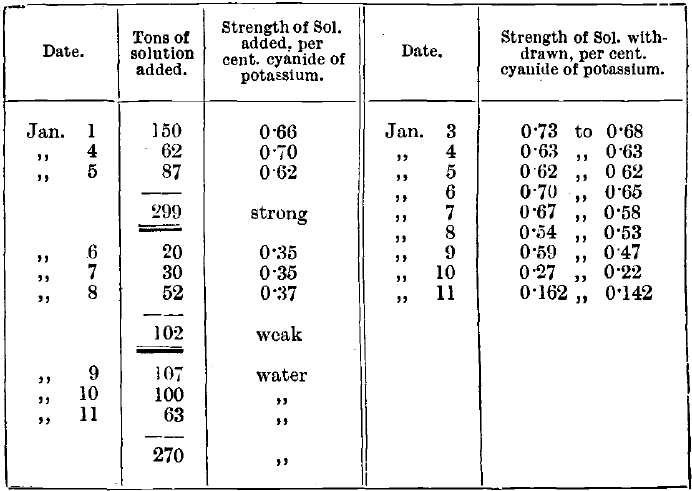The Chemical Precipitation on Mercury of the Gilmour – Young Process is a method that has been employed at the Santa Francisca Mine, Nicaragua. The ore contains a very large percentage of clay, the slimes amounting to 70 per cent, of the ore. The ore is crushed by a No. 5 Krupp ball mill through a 30-mesh sieve, and is charged into Boss pans, 4 feet in diameter, in 2-ton lots, with 100 gallons of water, so as to form a thick pulp. From two to six bottles of mercury are added, and circulation continued until the globules can be seen dispersed through the pulp, and then the required amount of cyanide. After running for two hours, 10 lbs. weight of mixed copper and zinc amalgam are added, and the pan run for four hours more. The gold is dissolved in the cyanide and precipitated by the zinc and copper, only 10 grains of gold per ton remaining in solution.
The pulp and solution are then discharged into a settler and diluted, and the mercury recovered in the ordinary way. The amalgam is used over again, and eventually a bullion 800 fine is obtained by retorting.
The power required for treating 50 tons per day is 24 H.P., and the labour costs are low. The copper sulphate and iron turnings are used to make the copper amalgam. The zinc amalgam is made by pouring mercury into molten zinc. The mean extraction was 83.6 per cent, of gold and 63.9 per cent, of silver from ore containing 1 oz. 5½ dwts. gold and 2 ozs. 7 dwts. silver, the tailings containing between 4 and 5 dwts. of gold.
As the hot ore passes along the conveyor to the tank building, and while it is yet very hot, it is sprinkled with strong cyanide solution (10 to 12 lbs. per ton of 2,000 lbs.) which reduces the time of treatment by 20 per cent., and usually gives a better percentage of extraction. The ore contains 4 or 5 per cent, of solution, and this has been found to be enough to give the benefit in time with little, if any, increased cost caused from the slight difficulty in handling. The Leaching Plant consists of four large buildings containing:

The aggregate tank capacity of about 6,300 tons is equal to 450 tons daily leaching capacity. The tanks are all made of steel, and vary in depth and size, the first installed being only 3 feet deep, while those in the second building were 50 feet in diameter and 5 feet deep, and those in the latest buildings 50 feet in diameter and 6 feet deep. The increase in depth was found to cause but little reduction in the rate of leaching, and it lessened the initial cost per ton considerably. All the tanks have bottom drains, bottom discharge valves, and wooden false bottoms. The wooden false bottoms are 5 or 6 inches from the tank bottom, and are made of inch lumber laid on radial strips, 2 inches x 4 inches or 2 inches x 6 inches, placed edgeways. The false bottoms are perforated with ¾-inch holes, and covered with cocoa fibre matting, covered with 10-oz. duck or canvas.
The empty tank has strong solution run into it until the solution stands 6 inches above the canvas. Filling with ore is then commenced and solution is run in at the same time from below, so that at about the time the tank is filled with ore the solution is just showing above the top. The ore is sampled as it is dumped into the tank, and duplicate assays for gold and silver are made. The first solution is allowed to stand on the ore for at least 24 hours and then drawn off, and more added and drawn off. This is repeated with strong solution until the ore is found by assay to have lost about two-thirds of the gold contents, after which weak solution is used until the extraction is such as to show that nothing can be gained by longer treatment; then the tank charge is washed with several waters, drained, sampled, and sluiced out. The sampling is all done by a large twist drill, 7 feet long, a number of holes being drilled at different places in the charge from top to bottom. Two samples are taken at each time, except in the case of “ finals,” and then four are taken.
A very careful record of each tank is kept, and no pains or work spared to ascertain the state and condition of each individual tank charge.
The accompanying scheme gives some idea of the leaching of a tank charge.
Tank charge, No. 1.
Time taken in filling, 50 hours.
Weight of ore, 434 tons.
Moisture, 5.4 per cent.
Weight of dry ore, 410 tons.

The assay of ore as charged into the tank was gold 0.90 oz., silver 0.50 oz. per ton, and the final tailings contained gold 0.06 oz., silver 0.20 oz. The percentage of precious metals extracted was gold 93.33 per cent, and silver 60.0 per cent.
The loss of cyanide was 1.75 lbs. per ton of ore treated. This charge took 303.15 hours from the time the men began to fill, the vat until the tank was empty and ready for another charge.
The method of discharging the tailings is cheap and efficient. Each tank has some six, eight, or more sluice valves in the bottom, and when the ore is ready to be discharged these are opened.
A man, dressed in rubber boots and coat, then gets into the tank and sluices the tailings out of the tank by means of a large fire hose, throwing a stream of water at 120 lbs. pressure.
All the tank sluice valves are connected with a central station, by means of wide sluice boxes, which carry the sludge to a large centrifugal pump about 3 feet in diameter.
The pump elevates the sludge into a wide sluice box on a high trestle, along which it flows out of the works on to the dump. The sand-pump station is capable of handling 100 tons of sand, or 300 tons of sludge per hour, and has often exceeded this; but, as a rule, the sluicing is not hurried, for the tank capacity is so large as never to cause a shortage of tank room. There are two of these pumps always ready in case of a breakdown, and they can be driven either by an electric motor or a small steam engine. The screen analysis of the tailings from the above charge was:

This shows a very even leach, for there is very little more in the slimes than in the main bulk, and as only 19 per cent, was coarser than 40-mesh, it would not pay to have crushed this originally to 40-mesh instead of to 30-mesh size in order to have gained the additional 0.01 oz. of gold.
